Cells That Read Minds
By SANDRA BLAKESLEE
Published: January 10, 2006
Copyright New York Times 2006
MONKEY SEE When a monkey watches a researcher bring an object—an ice cream cone, for example— to his mouth, the same brain neurons fire as when the monkey brings a peanut to its own mouth. In the early 1990's, Italian researchers discovered this phenomenon and named the cells "mirror neurons."
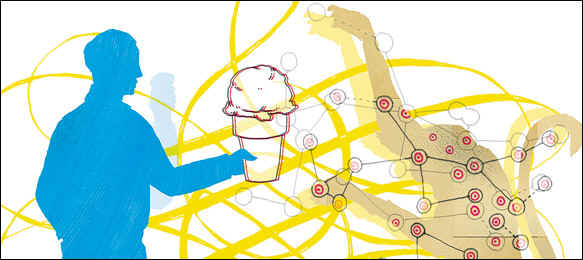 |
| MONKEY SEE When a monkey watches a researcher bring an object—an ice cream cone, for example— to his mouth, the same brain neurons fire as when the monkey brings a peanut to its own mouth. In the early 1990's, Italian researchers discovered this phenomenon and named the cells "mirror neurons." |
On a hot summer day 15 years ago in Parma, Italy, a monkey sat in a special laboratory chair waiting for researchers to return from lunch. Thin wires had been implanted in the region of its brain involved in planning and carrying out movements.
Every time the monkey grasped and moved an object, some cells in that brain region would fire, and a monitor would register a sound: brrrrrip, brrrrrip, brrrrrip.
A graduate student entered the lab with an ice cream cone in his hand. The monkey stared at him. Then, something amazing happened: when the student raised the cone to his lips, the monitor sounded - brrrrrip, brrrrrip, brrrrrip - even though the monkey had not moved but had simply observed the student grasping the cone and moving it to his mouth.
The researchers, led by Giacomo Rizzolatti, a neuroscientist at the University of Parma, had earlier noticed the same strange phenomenon with peanuts. The same brain cells fired when the monkey watched humans or other monkeys bring peanuts to their mouths as when the monkey itself brought a peanut to its mouth.
Later, the scientists found cells that fired when the monkey broke open a peanut or heard someone break a peanut. The same thing happened with bananas, raisins and all kinds of other objects.
"It took us several years to believe what we were seeing," Dr. Rizzolatti said in a recent interview. The monkey brain contains a special class of cells, called mirror neurons, that fire when the animal sees or hears an action and when the animal carries out the same action on its own.
But if the findings, published in 1996, surprised most scientists, recent research has left them flabbergasted. Humans, it turns out, have mirror neurons that are far smarter, more flexible and more highly evolved than any of those found in monkeys, a fact that scientists say reflects the evolution of humans' sophisticated social abilities.
The human brain has multiple mirror neuron systems that specialize in carrying out and understanding not just the actions of others but their intentions, the social meaning of their behavior and their emotions.
"We are exquisitely social creatures," Dr. Rizzolatti said. "Our survival depends on understanding the actions, intentions and emotions of others."
He continued, "Mirror neurons allow us to grasp the minds of others not through conceptual reasoning but through direct simulation. By feeling, not by thinking."
The discovery is shaking up numerous scientific disciplines, shifting the understanding of culture, empathy, philosophy, language, imitation, autism and psychotherapy.
Everyday experiences are also being viewed in a new light. Mirror neurons reveal how children learn, why people respond to certain types of sports, dance, music and art, why watching media violence may be harmful and why many men like pornography.
How can a single mirror neuron or system of mirror neurons be so incredibly smart?
Most nerve cells in the brain are comparatively pedestrian. Many specialize in detecting ordinary features of the outside world. Some fire when they encounter a horizontal line while others are dedicated to vertical lines. Others detect a single frequency of sound or a direction of movement.
Moving to higher levels of the brain, scientists find groups of neurons that detect far more complex features like faces, hands or expressive body language. Still other neurons help the body plan movements and assume complex postures.
Mirror neurons make these complex cells look like numbskulls. Found in several areas of the brain - including the premotor cortex, the posterior parietal lobe, the superior temporal sulcus and the insula - they fire in response to chains of actions linked to intentions.
Studies show that some mirror neurons fire when a person reaches for a glass or watches someone else reach for a glass; others fire when the person puts the glass down and still others fire when the person reaches for a toothbrush and so on. They respond when someone kicks a ball, sees a ball being kicked, hears a ball being kicked and says or hears the word "kick."
"When you see me perform an action - such as picking up a baseball - you automatically simulate the action in your own brain," said Dr. Marco Iacoboni, a neuroscientist at the University of California, Los Angeles, who studies mirror neurons. "Circuits in your brain, which we do not yet entirely understand, inhibit you from moving while you simulate," he said. "But you understand my action because you have in your brain a template for that action based on your own movements.
"When you see me pull my arm back, as if to throw the ball, you also have in your brain a copy of what I am doing and it helps you understand my goal. Because of mirror neurons, you can read my intentions. You know what I am going to do next."
He continued: "And if you see me choke up, in emotional distress from striking out at home plate, mirror neurons in your brain simulate my distress. You automatically have empathy for me. You know how I feel because you literally feel what I am feeling."
Mirror neurons seem to analyzed scenes and to read minds. If you see someone reach toward a bookshelf and his hand is out of sight, you have little doubt that he is going to pick up a book because your mirror neurons tell you so.
In a study published in March 2005 in Public Library of Science, Dr. Iacoboni and his colleagues reported that mirror neurons could discern if another person who was picking up a cup of tea planned to drink from it or clear it from the table. "Mirror neurons provide a powerful biological foundation for the evolution of culture," said Patricia Greenfield, a psychologist at the U.C.L.A. who studies human development.
Until now, scholars have treated culture as fundamentally separate from biology, she said. "But now we see that mirror neurons absorb culture directly, with each generation teaching the next by social sharing, imitation and observation."
Other animals - monkeys, probably apes and possibly elephants, dolphins and dogs - have rudimentary mirror neurons, several mirror neuron experts said. But humans, with their huge working memory, carry out far more sophisticated imitations.
Language is based on mirror neurons, according to Michael Arbib, a neuroscientist at the University of Southern California. One such system, found in the front of the brain, contains overlapping circuitry for spoken language and sign language.
In an article published in Trends in Neuroscience in March 1998, Dr. Arbib described how complex hand gestures and the complex tongue and lip movements used in making sentences use the same machinery. Autism, some researchers believe, may involve broken mirror neurons. A study published in the Jan. 6 issue of Nature Neuroscience by Mirella Dapretto, a neuroscientist at U.C.L.A., found that while many people with autism can identify an emotional expression, like sadness, on another person's face, or imitate sad looks with their own faces, they do not feel the emotional significance of the imitated emotion. From observing other people, they do not know what it feels like to be sad, angry, disgusted or surprised.
Mirror neurons provide clues to how children learn: they kick in at birth. Dr. Andrew Meltzoff at the University of Washington has published studies showing that infants a few minutes old will stick out their tongues at adults doing the same thing. More than other primates, human children are hard-wired for imitation, he said, their mirror neurons involved in observing what others do and practicing doing the same things.
Still, there is one caveat, Dr. Iacoboni said. Mirror neurons work best in real life, when people are face to face. Virtual reality and videos are shadowy substitutes.
Nevertheless, a study in the January 2006 issue of Media Psychology found that when children watched violent television programs, mirror neurons, as well as several brain regions involved in aggression were activated, increasing the probability that the children would behave violently.
The ability to share the emotions of others appears to be intimately linked to the functioning of mirror neurons, said Dr. Christian Keysers, who studies the neural basis of empathy at the University of Groningen in the Netherlands and who has published several recent articles on the topic in Neuron.
When you see someone touched in a painful way, your own pain areas are activated, he said. When you see a spider crawl up someone's leg, you feel a creepy sensation because your mirror neurons are firing.
People who rank high on a scale measuring empathy have particularly active mirror neurons systems, Dr. Keysers said.
Social emotions like guilt, shame, pride, embarrassment, disgust and lust are based on a uniquely human mirror neuron system found in a part of the brain called the insula, Dr. Keysers said. In a study not yet published, he found that when people watched a hand go forward to caress someone and then saw another hand push it away rudely, the insula registered the social pain of rejection. Humiliation appears to be mapped in the brain by the same mechanisms that encode real physical pain, he said.
Psychotherapists are understandably enthralled by the discovery of mirror neurons, said Dr. Daniel Siegel, the director of the Center for Human Development in Los Angeles and the author of "Parenting From the Inside Out," because they provide a possible neurobiological basis for the psychological mechanisms known as transference and countertransference.
In transference, clients "transfer" feelings about important figures in their lives onto a therapist. Similarly, in countertransference, a therapist's reactions to a client are shaped by the therapist's own earlier relationships.
Therapists can use their own mirror system to understand a client's problems and to generate empathy, he said. And they can help clients understand that many of their experiences stem from what other people have said or done to them in the past.
Art exploits mirror neurons, said Dr. Vittorio Gallese, a neuroscientist at Parma University. When you see the Baroque sculptor Gian Lorenzo Bernini's hand of divinity grasping marble, you see the hand as if it were grasping flesh, he said. Experiments show that when you read a novel, you memorize positions of objects from the narrator's point of view.
Professional athletes and coaches, who often use mental practice and imagery, have long exploited the brain's mirror properties perhaps without knowing their biological basis, Dr. Iacoboni said. Observation directly improves muscle performance via mirror neurons.
Similarly, millions of fans who watch their favorite sports on television are hooked by mirror neuron activation. In someone who has never played a sport - say tennis - the mirror neurons involved in running, swaying and swinging the arms will be activated, Dr. Iacoboni said.
But in someone who plays tennis, the mirror systems will be highly activated when an overhead smash is observed. Watching a game, that person will be better able to predict what will happen next, he said.
In yet another realm, mirror neurons are powerfully activated by pornography, several scientists said. For example, when a man watches another man have sexual intercourse with a woman, the observer's mirror neurons spring into action. The vicarious thrill of watching sex, it turns out, is not so vicarious after all.
| Slide Show by Laura Wells |
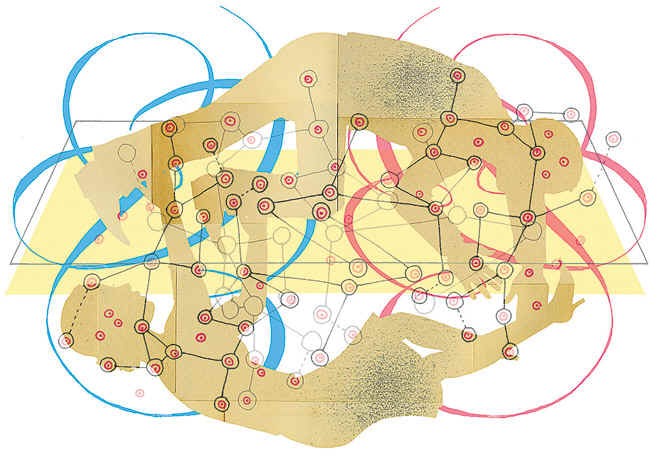 |
| I FEEL YOUR PAIN Social emotions like guilt, shame, pride, embarrassment, disgust and lust are based on a uniquely human mirror neuron system found in a part of the brain called the insula, researchers say. In one study, people watched a hand move forward to caress someone else and then saw another hand push it away rudely. The insula region of their brains registered the social pain of rejection. |
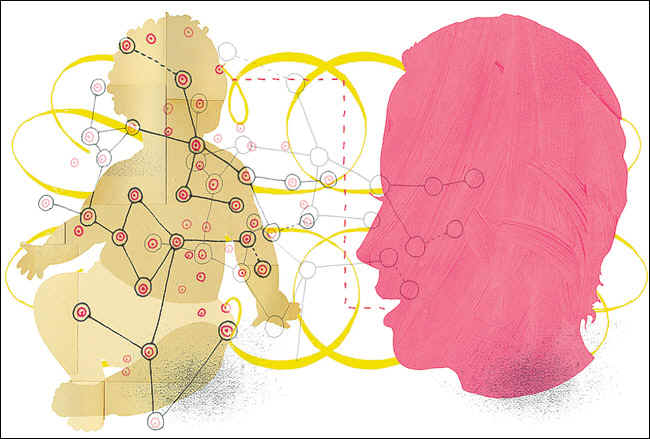 |
| LEARNING BY WATCHING More than other primates, humans are hard-wired for imitation. An infant a few days old will stick out his tongue after watching his mother do the same thing. Mirror neurons, researchers have found, begin working at birth. They are involved when a child observes an action and then practices performing it. |
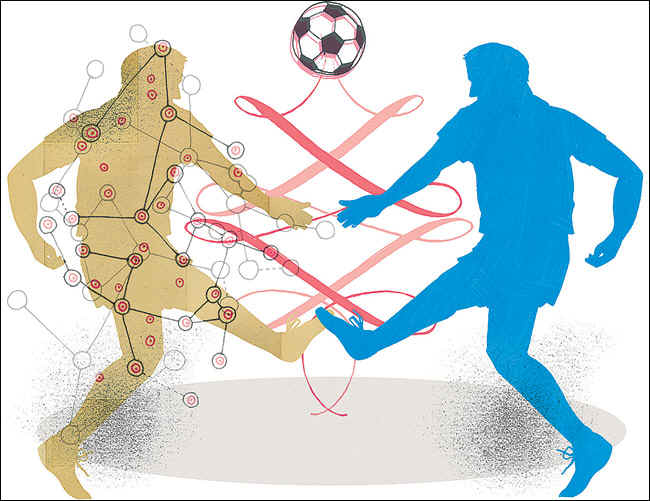 |
| AMAZING FEATS In humans, mirror neurons are much smarter, more flexible and more highly evolved than in monkeys, scientists have found, and they appear to be involved not only in actions but in intentions and emotions—the things that make humans social animals. When a person watches someone else perform an action—say a kick—mirror neurons in the brain simulate the action and provide a template for anticipating what will happen next. |
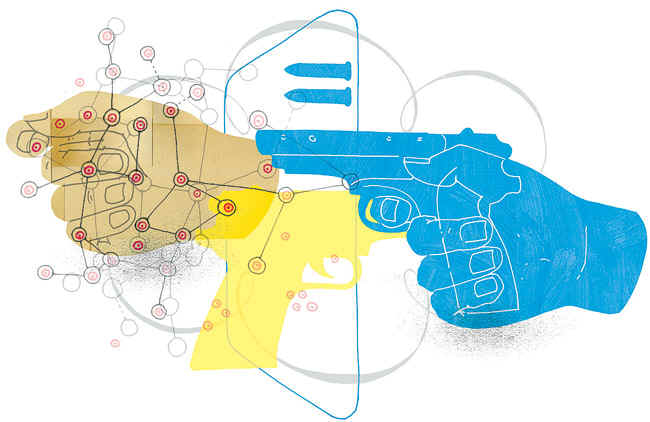 |
| MODELS OF AGGRESSION Mirror neurons are at their best when humans are face to face. But at least one study found that the cells, along with several brain areas involved in aggression, were activated when children watched a violent television program. That activation increased the chances that the children would behave aggressively minutes or hours later. |




